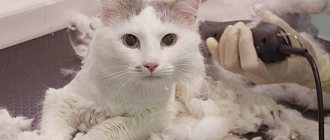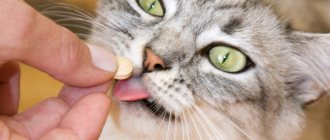Symptoms of fever in a cat
The cause of an increase in body temperature in a cat can be determined by the accompanying symptoms:
- increased tear production;
- runny nose;
- lethargy;
- the cat does not eat or drink;
- nose dry and hot;
- vomit;
- uncharacteristic, anxious or aggressive behavior;
- cardiopalmus;
- convulsions;
- indigestion;
- change in color of the oral mucosa, nose and visual organs;
- shortness of breath and wheezing when exhaling;
- Covering the cat's skin with hemorrhages.
All of the above symptoms indicate that the increase in temperature was not due to banal overheating of the body and the cat urgently needs first aid at home, and then taken to a veterinarian for further treatment. If the pet is not provided with medical assistance in a timely manner, after two days irreversible changes will begin in its body, ultimately leading to cardiac arrest.
Fever in pets is often accompanied by apathy, lack of activity and decreased appetite. The animal may even refuse water and spend most of its time lying on its side. At the same time, the cat often hides from its owner in a secluded place where no one will disturb it:
- If your pet additionally has diarrhea and vomiting, this may indicate food poisoning or acute gastrointestinal diseases: ulcers, pancreatitis and liver damage. In this case, tachycardia may also occur, the animal’s fur loses its shine and falls off.
When the temperature rises, the pet often experiences apathy and lack of appetite.
- If the pet does not allow you to touch its belly and reacts to any attempt with a plaintive meow or aggression, then this behavior indicates pathologies of the abdominal cavity.
- When the temperature rises, you need to examine your pet’s skin. In the presence of sores, wounds and rashes, tick-borne encephalitis, lichen or severe allergic reactions can be suspected.
A slight increase in body temperature does not actually affect the general condition of the cat, as well as its daily behavior.
Often, such an ailment goes away on its own and does not require any adjustments from the owner. It's another matter when the degrees begin to skyrocket. The first signs of oppression can be observed already at a temperature of 40 degrees.
The symptoms look like this:
- lack of appetite;
- lethargy;
- drowsiness (the cat sleeps constantly);
- apathy;
- tremor;
- cardiopalmus.
Some owners determine if their pet has a high fever by feeling the nose for signs of moisture. However, this method is completely ineffective.
For example, cats' noses dry out only in the presence of very high temperatures. Also, during the sleep process, the nasal epithelium also remains dry.
Attention: Sphynx cats have a normal body temperature of 41-42 degrees. This is due to the individual characteristics of the body of these animals and the lack of the usual coat.
Clinical picture
In order to timely diagnose the presence of symptoms in an animal, it is necessary to monitor its well-being and behavior.
General symptoms manifest themselves as follows:
:
- Loose stools and nausea. If your pet has blood in its stool, you should immediately show it to a doctor. This may be a warning sign indicating internal bleeding.
- Rapid heartbeat and other heart rhythm disturbances
- Violation of the integrity of the skin - hemorrhages, etc.
- Difficulty breathing and shortness of breath.
- Decreased appetite
- Lethargic, apathetic behavior
- Body trembling
- Changes in habitual behavior
- General dehydration of the body, dry mucous membranes.
Next steps will depend on how severe your pet's condition is. In some cases, assistance at home is sufficient.
The animal’s body can cope with the infection on its own. But with the general severity of the symptoms, if the cat has a fever and does not eat anything, it is better to seek qualified help.
For example, this applies to conditions such as heat stroke. Self-medicating in this case can be dangerous.
You should know that fever in cats does not occur without a reason. Therefore, even if you manage to bring down the temperature, the disease that caused it to rise may remain. The veterinarian will help determine the causes of the animal’s illness and prescribe the necessary medications if necessary.
What temperature is considered normal for cats?
The temperature in cats, unlike in humans, is considered normal in the range from 37.8 to 39 degrees. Higher values indicate a pathological process or overheating of the body. An increase in temperature cannot be ignored, as the cause may be a serious pathology.
Normally, a cat’s body is designed in such a way that excess heat is eliminated naturally through the skin and respiratory system. If the pet is sick, then this process of thermoregulation is disrupted.
A cat's normal body temperature is ensured by the body's natural thermoregulation.
Causes of fever in pets
When the body overheats and is stressed, the cat’s body temperature does not exceed 40 degrees. In most cases, the cause of fever can be a viral or bacterial infection that occurs in an acute form. The chronic course of pathologies is rarely accompanied by an increase in temperature. Disturbances in thermoregulation can be caused by toxins that accumulate in the body in the presence of parasites, protozoa and bacterial flora.
A cat's temperature often rises when there is a bacterial or viral infection.
The following diseases and pathological conditions contribute to an increase in temperature (hyperthermia):
- inflammatory pathologies of the ENT organs: otitis media;
- bronchitis;
- pneumonia;
- cystitis;
Processes of necrosis (death) of tissues in the body can also provoke an elevated temperature in an animal, so if there is a fever, it is necessary to show your pet to a veterinarian.
What to do?
What to do if a cat has a fever and what measures should be taken first?
To begin, place the animal in the most comfortable place for it and do the following:
- Ventilate the room; the air in the room where the animal is located should be cool. Open the windows or turn on the air conditioner or fan.
- Give your cat a drink of Regidron solution if dehydration occurs.
- Cover your pet with a damp, cool towel.
- Offer your cat low-fat chicken broth.
- Do not wet your pet's fur - this creates a dense, impenetrable layer that interferes with normal thermoregulation.
- Provide your pet with peace.
Attention: the animal should not be forced to drink or eat. Forced drinking is only possible if the pet is dehydrated.
If the cat feels better after a while, then offer him low-fat food, for example, boiled chicken or fish.
A cat’s body temperature, which stays between 40-41 degrees, is critical, as it provokes severe loss of fluid, swelling of the respiratory tract, as well as the brain.
This condition of the pet requires immediate medical attention.
However, first you should try to reduce the temperature at least a little:
- Place an ice pack on your cat's inner thigh.
- Wet your animal's paws and belly with cool water.
- The cat must be force-fed cool water in small portions.
You should not give any antipyretics to your cat, even if they are intended for children. Medicines with excessively high thermometer readings can lead to the most unpleasant consequences and even the death of a pet.
READ What should be a normal temperature for a cat, what is the critical temperature and normal temperature after sterilization
If the temperature rises slightly, it is not necessary to take any measures, but even this does not cancel a trip to the doctor. If your cat has a high fever, you can use echinacea tincture, which stimulates the body's defenses. There should be 1 ml of medicine per 1 kg of weight:
- The required amount of tincture should be mixed with boiled water (1 tbsp.).
- Draw the liquid into a syringe without a needle and forcefully give it to your pet.
- It is not recommended to use the product more than once a day.
Echinacea tincture stimulates the immune system
Additionally, you can use Regidron solution, which will replenish the fluid deficiency in your pet’s body and improve its well-being by preventing dehydration. 1 sachet needs to be filled with 1 liter of water and mixed thoroughly. The solution should be given 20 ml 3-4 times a day forcibly.
Rehydron replenishes fluid deficiency in the body
One day my cat got sick, which I identified by its characteristic signs. Kesha did not get up, and his nose was warm. In this case, due to lack of experience, I turned to my neighbor, an avid cat lover. In front of me, she measured the pet’s temperature by inserting a mercury thermometer into his anus. As it turned out, my pet had a fever, the cause of which was inflammation of the kidneys, which was clear from the animal sitting on the tray for a long time.
Traditional methods
To reduce your pet's temperature, you can use cool water to wet the animal's paws. However, you should never bathe a cat while sick. Cool water should be used not only externally, but also given to the pet internally using a syringe every few hours, 10-20 ml to prevent dangerous consequences.
If the temperature is close to 41 degrees, then it is recommended to wipe the cat’s paw pads with vodka or alcohol (it should be diluted half with water) every hour. For the same purposes, you can use 4% apple cider vinegar diluted with water 1:1. This procedure will ease the animal’s condition and help lower the temperature slightly.
Apple cider vinegar can be used to wipe your pet's paws
In extreme heat, you can apply ice wrapped in a towel to your pet's body, avoiding the abdominal area. This product should only be used urgently. It is not recommended to use it regularly. To alleviate your pet’s condition, you can turn on the air conditioning, but only to reduce the temperature in the room by a few degrees.
Causes of increased body temperature
Normally, it is 38-39 degrees in adult cats and cats, and slightly higher in young animals. Representatives of the Sphynx breed have a higher body temperature than other animals. It is normally 41-42 degrees.
So, why might pets have an elevated body temperature? Here are the most common reasons for this phenomenon:
- Normal overheating. When a pet stays in the sun for a long time or in a too hot room, car, train, the body temperature can rise above 41 degrees. In such situations, it is recommended to move the animal to a cool room, give it cold water to drink, and place it on the floor. Usually after an hour or two the cat returns to normal and perks up.
- Infectious and viral diseases. If your pet also experiences weakness, decreased urination, and vomiting, then most likely an infection has been contracted. The body will fight the infectious disease, including an increase in body temperature. The body reacts similarly to viruses, only in this case your child will sneeze and may experience watery eyes and nasal discharge.
- Stress, emotional shock. There are breeds of animals that are strongly attached to their owners. Their long-term absence in cats causes severe stress, which can also manifest itself as an increase in temperature. This sometimes happens after visiting exhibitions, moving, or the death of the owner.
- Active games, entertainment. Having run around and played enough, the animal overheats a little. But, having calmed down and rested, he returns to normal - everything stabilizes.
- Pregnancy. Due to physiological processes, the body temperature of expectant mothers can sometimes increase by one to one and a half degrees.
- Oncology. It develops more often in older cats. In such cases, it is very difficult to normalize blood counts, the functioning of internal organs and temperature.
The appearance of such an unpleasant symptom in a cat as a high temperature can be associated with a variety of factors. Some of them are quite harmless, and some should force you to resort to prompt actions that will correct the pet’s condition and improve its well-being.
So, a cat may develop a fever in the following cases:
- Stress and emotional overstrain - cats by their nature are extremely emotional and impressionable animals. A long separation from the owner, the arrival of a new pet in the house, as well as moving - all these moments have a particularly negative impact not only on the psychological, but also on the physical condition of the cat. The temperature does not rise significantly. The pet may experience food refusal, a depressed and lethargic state. Typically, such a disorder goes away on its own once the cause of the stress has been eliminated.
- Overheating is a problem faced by animals that often go out on their own. Prolonged lack of fluid, as well as exposure to direct sunlight, causes the body to begin to suffer from dehydration. Also, severe overheating can occur if you leave your pet in a hot car for a long time.
- Infectious disease - any illness of an infectious nature manifests itself with an increase in body temperature. Additionally, negative signs such as vomiting, lethargy, muscle weakness, loss of appetite, and indigestion appear.
- A viral disease significantly affects the condition of the cat. Any virus quickly affects the animal’s body. Additionally, a cough appears and mucus is released from the nose.
- Poisoning - intoxication of a pet’s body with low-quality food or household chemicals is manifested not only by fever, but also by severe vomiting, as well as a complete apathetic state. The animal also breathes heavily and constantly lies down.
READ What temperature should a fish aquarium be?
Attention: sometimes temperature can indicate the presence of cancer. In this case, only a veterinarian can confirm or refute the diagnosis by conducting a complete diagnostic examination of the pet.
A cat's high body temperature should not always be a reason to visit the veterinarian, since in certain cases this symptom does not indicate a serious illness in the pet. A cat’s temperature rises for the following reasons:
- 1. Normal body overheating. If an animal has been in a stuffy, enclosed room or exposed to direct sunlight for a long time, overheating occurs.
- 2. Stress recently experienced by the pet. A long separation from the owner, moving, a sudden change of environment, visiting a veterinary clinic and participating in an exhibition - all these events are stressful for a cat.
- 3. Increased physical activity.
- 4. Eating food. During a meal, the cat's temperature rises, and this phenomenon is normal.
It is worth sounding the alarm in cases where the temperature rises due to the occurrence of a certain disease in the cat. As a rule, this symptom indicates that the pet has one of the following ailments:
- infectious disease;
- various poisonings;
- malignant tumor;
- viral infection of the body;
- failure of the endocrine system;
- serious metabolic disorder.
In order to bring down an animal’s temperature at home, you must follow the following algorithm of actions:
- place the cat in a cool and well-ventilated room in the apartment;
- provide fresh air access to the room by opening the door and windows;
- turn on the air conditioner or fan;
- apply ice cubes or a towel or napkin soaked in cold water to the pet’s neck;
- periodically re-wet the towel and apply a cold compress;
- cover the cat's body with gauze soaked in cool water (care should be taken to prevent hypothermia);
- Give your cat water to prevent dehydration;
- Lubricate your pet's paw pads with a solution of vinegar and medical alcohol, doing the procedure every hour.
It is recommended to feed your cat dietary meals, preferably liquid ones. Low-fat chicken broth is best. To lower the temperature, you can resort to medicinal herbs, for example, echinacea tincture, which helps fight infection and suppress the virus. It must be dissolved in a small amount of water in a ratio of 1 drop per 1 kg of cat weight.
When the body overheats and is stressed, the cat’s body temperature does not exceed 40 degrees. In most cases, the cause of fever can be a viral or bacterial infection that occurs in an acute form. The chronic course of pathologies is rarely accompanied by an increase in temperature. Disturbances in thermoregulation can be caused by toxins that accumulate in the body in the presence of parasites, protozoa and bacterial flora.
A cat's temperature often rises when there is a bacterial or viral infection.
The following diseases and pathological conditions contribute to an increase in temperature (hyperthermia):
- inflammatory pathologies of ENT organs:
- genitourinary system infections:
- food poisoning;
- severe injuries;
- fungal skin infections;
- severe allergic reactions.
Normal indicators
The temperature in cats, unlike in humans, is considered normal in the range from 37.8 to 39 degrees. Higher values indicate a pathological process or overheating of the body. An increase in temperature cannot be ignored, as the cause may be a serious pathology.
Normally, a cat’s body is designed in such a way that excess heat is eliminated naturally through the skin and respiratory system. If the pet is sick, then this process of thermoregulation is disrupted.
A cat's normal body temperature is ensured by the body's natural thermoregulation.
The content of the article
A cat’s temperature, like that of any other creature, is one of the main indicators of health. An elevated body temperature can be a minor overheating condition or a serious symptom. It is very important to monitor the health of the animal, because the cat cannot tell about pain or discomfort.
Normally, a cat's temperature is 38-39 degrees. Kittens have a slightly higher body temperature than adult cats. Body temperature also depends on the time of year - in summer it is higher. Sphynx cats have a high body temperature. Normally it is 41-42 degrees. In other cases, the temperature increase may be due to the following reasons.
- Simple, banal overheating. If a cat is forced to spend some time in the sun, its body temperature can rise above 41 degrees. This can happen if the cat is locked in a stuffy room or while the animal is being transported. In this case, you need to move the cat to a cool place and give it water. Usually the temperature stabilizes within a few hours.
- Sometimes cats encounter infectious diseases. If your pet, in addition to a high temperature, experiences vomiting, weakness, lack of appetite, and decreased urination, this is a serious reason to contact a veterinarian.
- Cats also get sick from viral diseases. In this case, you may experience tearing, mucus from the nose, and sneezing. In case of viral diseases, it is important to ensure high humidity in the room and give the cat enough to drink.
- High temperature may be a consequence of emotional shock. Often cats show anxiety after visiting exhibitions, the veterinarian, after moving or losing their owner. In this case, calm the animal and, if possible, bring the cat into its usual habitat. Stress fever usually goes away quickly once everything is back to normal.
- Often the body temperature rises due to the animal's physical activity. But this increase is insignificant - no more than 1 degree.
- Sometimes body temperature increases in pregnant cats due to physiological processes.
- Often, a high temperature in a cat is associated with oncology, so wondering about the diagnosis and procrastinating is a crime. Show the animal to the veterinarian and make sure there are no irreversible processes.
But sometimes it happens that the whole point is in the incorrect measurement of the animal’s body temperature.
how to make a cat vomit at home
The cat's body temperature should be measured rectally. For this purpose, the pet is pre-swaddled. It would be nice if the procedure was carried out by two people - one holds the cat, and the second measures the temperature.
Lift the cat's tail and lubricate the anus with oil, Vaseline or cream. Lubricate the tip of the thermometer as well. It is best to use an electronic thermometer, as it works quickly and gives a signal immediately after the temperature measurement is completed. But if there is no such thermometer, you can use a regular mercury thermometer.
The tip is inserted 3-4 cm into the anus with circular movements and within 5 minutes you will know the exact body temperature of your pet.
So, the cat has been diagnosed with high body temperature. It is very important here to find out the true cause of hyperthermia and respond with immediate action.
- To begin, place the animal in a cool room. Open the windows in winter, and in summer, on the contrary, turn on the air conditioner or fan.
- Place wet rollers or ice wrapped in a towel on your inner thighs and behind your ears. You can cover the animal with a wet towel.
- Provide your cat with enough water to drink.
- If the situation is urgent, and you need to see a doctor only in the morning, you can smear the cat’s paw pads with alcohol, vodka or diluted vinegar every hour.
- Under no circumstances should you wet the animal. Wet fur will be a dense barrier to thermoregulation.
- Sometimes high temperatures can cause dehydration. Especially if it is accompanied by vomiting or diarrhea. When dehydrated, a cat behaves very lethargically, sleeps a lot, and does not urinate. In this case, it is very important to water the animal to restore the salt balance. Dissolve one sachet of Regidron in a liter of water. Offer your cat to drink this mixture. If she refuses, you need to force the solution in, because dehydration is very dangerous for the cat. Wrap the animal in a diaper and use a syringe without a needle to pour the solution into the mouth.
- Some points on the animal’s body are responsible for the course of life processes. To reduce the temperature, you need to do an acupuncture massage of a point located on the back paw. On the outside of the paw, under the knee bend, massage and press the skin, and within a minute you will notice that the temperature has begun to subside. But this method is only effective if the high temperature is caused by an infection.
- During periods of elevated body temperature, offer the animal dietary and light meals, mainly liquid ones. It is best if the cat laps up chicken broth.
- If you have a fever, you can give your cat echinacea tincture. It fights infection, strengthens the immune system, and suppresses the virus. Dissolve the tincture in a small amount of water at the rate of 1 drop per 1 kg of animal weight. Pour the prepared solution into the cat's mouth with a syringe.
We invite you to read: Azinox for cats: indications and instructions for use, reviews, price
Remember, fever is a serious symptom. Even if you manage to knock it down, it is very important to see a veterinarian as soon as possible. Most likely, you need to fight not with temperature, but with the disease that caused hyperthermia. Take care of your animal, because it has no one to rely on except you.
how to remove fur from a cat's stomach
Having pets in the house is a big responsibility. But in addition to a good diet and leisure time for the furry pet, the owner must monitor the animal’s health. Cats, like other animals, sometimes experience troubles such as fever.
When sick, pets cannot say what hurts them or what caused the illness. The owner must take a responsible approach to ensuring a prosperous lifestyle for the pet. Loving owners always notice any deviation in the behavior of the animal, and can immediately determine that something is wrong with it. How to reduce a cat's fever at home? What should the owner know?
Healthy cats have:
- good appetite;
- shiny coat;
- wet, cold nose;
- uniform color of the mucous membranes - a uniform pink color (the shade may differ slightly in different individuals).
If a person's temperature is considered normal at 35.9 to 37.2 °C, then in a cat they are always higher - 38-39 degrees. There is an opinion that a temperature of 42 °C is considered normal for representatives of hairless breeds.
In fact, for Sphynxes it is the same as for long-haired cats. It's just that your pet's skin always feels hot when touched. It is not surprising, because there is no fur on it.
A slight increase in temperature in cats is always observed during the hot season. Indicators may vary throughout the day. So, during sleep and in the morning after waking up they are lower, but after physical activity, eating and in the late afternoon, on the contrary, they are increased. There's nothing wrong with that.
A temperature jump of 1 degree upward during estrus, pregnancy, childbirth, as well as after sterilization and vaccination should not cause concern.
It should be noted that in kittens the mechanism of thermoregulation is formed gradually. In newborns, the readings are considered normal: 35.5 to 36.5 ℃; in babies 1-2 months old, they range from 38.5 to 39.5 degrees. Once the kittens reach 7 months of age, the indicators stabilize.
An increase in body temperature in a pet can be caused by a variety of reasons. The most common of these is ordinary overheating. If the cat has been in the sun or in a stuffy room for a long time, the readings can jump up to 41 degrees.
To stabilize the temperature, it is enough to place the animal in a cool room and give it water to drink. As a rule, after a couple of hours thermoregulation returns to normal.
Temperature can also rise significantly due to stress. Cats are emotional, and the appearance of another pet in the house, moving to a new place of residence, changing or losing an owner, even a banal trip by car to the veterinary clinic causes them great anxiety.
The animal's condition will stabilize as soon as it feels that it is not in danger and its loving owner is still nearby.
Hyperthermia can be triggered by infections. In such cases, the pet experiences symptoms such as diarrhea, vomiting, urinary retention, lack of appetite, and weight loss. Infectious diseases are very dangerous and require immediate attention to a veterinarian.
If a cat's fever is accompanied by sneezing, mucous discharge from the nose, and watery eyes, it is most likely that the body is infected with a virus. In such cases, it is also necessary to visit a veterinary hospital.
The four-legged pet's temperature should be measured rectally with a thermometer. It makes no sense to measure under the paw, since all animals have hair, and the result will be incorrect.
What can you do at home?
Traditional methods
When a cat develops a symptom such as a high temperature, the owner must understand that the help of a veterinarian in this case is simply irreplaceable.
However, if for some reason you cannot go to a veterinary clinic within a few hours, and the animal only gets worse, then there is only one rational solution - try to reduce the temperature at home.
You must act carefully, weighing the possible risks and benefits.
Combine diphenhydramine 0.3 ml with analgin 0.3 ml in one syringe and inject the cat intramuscularly into the hind leg. By analogy, you can use papaverine.
The best and safer option would be to wrap the animal in cool, damp gauze and take it to the clinic.
How dangerous is a fever in an animal?
High temperatures pose a huge danger to cats. Exposure to temperatures above 40-41 degrees for several days leads to irreversible processes in the body. The pet becomes dehydrated, swelling of the brain and disruption of the functioning of a number of internal organs may occur.
So, first you need to not panic. Try to remember how your cat behaved over the past few days, what it ate and whether it was outside or in contact with other animals or strangers.
READ How to name a Sphynx boy and a girl: suitable names for cats
If the animal’s condition is not critical, namely, the pet does not refuse food and water, but prefers to sleep most of the time, monitor it for exactly 24 hours. If within 24 hours the condition remains the same or worsens, then go to the doctor.
An indicator of an increase in a cat's body temperature is the nose. If it is cool and damp, then the pet is healthy. A warm and dry nose indicates hyperthermia. However, this method does not make it possible to determine accurate data. In order to measure the animal's temperature, you will need a mercury or electronic thermometer.
First of all, you need to prepare any available tool that will help you easily and painlessly insert the thermometer into the rectum. This could be Levomekol ointment, Vaseline or baby cream. Before the procedure, the pet should be carefully secured by wrapping it in a towel. It is good if someone helps, since it is difficult to do this on your own, especially when the cat is aggressive.
To measure temperature, you can use either an electronic or a mercury thermometer
After fixing, the tip of the thermometer must be lubricated with any of the listed products and carefully inserted into the animal’s anus to a depth of no more than 1 cm. If we are talking about a standard mercury thermometer, then you will have to wait from three to five minutes. Electronic thermometers cope with the task faster. After measuring the temperature, the device must be carefully removed from the rectum.
Measuring a cat's body temperature is done rectally
How to determine malaise?
The first signs of illness
:
- Digestion is disturbed, there is a lack of appetite and vomiting;
- temperature rises;
- pulse and breathing increase;
- the animal becomes lethargic, inactive and sleeps a lot;
- The cat also has difficulty urinating and goes to the toilet frequently.
To be sure that a cat has a normal body temperature, you should not rely only on general external signs. It is best to measure this indicator using appropriate devices. To do this, you can use a veterinary or medical thermometer. Any owner must be able to properly handle the device to most accurately determine temperature readings.
The end is lubricated with Vaseline or vegetable oil, then carefully inserted into the rectum, no deeper than 1.5 cm. The thermometer is held for about 5 minutes. Many owners prefer electronic thermometers, which need to be held for no more than a couple of seconds.
When to contact a veterinarian
If your pet's temperature is 41 degrees, it is important to consult a doctor immediately. You can’t hesitate, otherwise the consequences can be very sad. In addition, consultation with a specialist is also important in the case when a cat has a temperature of 40 degrees, but lasts for more than a day. Immediate hospitalization is needed for fever, which is accompanied by vomiting and diarrhea. In this case, dehydration can occur in the shortest possible time and cause death.
In a clinical setting, a doctor is able to identify the cause. For these purposes, the veterinarian takes blood from the animal’s vein and also examines the skin. To eliminate bacterial and viral infections, the doctor prescribes antibiotics and immunostimulants. The most effective way to administer the medicine is by injection. It allows you to quickly eliminate the source of infection and bring down the temperature. The following are often used for therapy:
- Amoxicillin;
- Sinulox;
- Tsiprovet.
Sinulox is used to eliminate bacterial infections
To eliminate a viral infection, the following is prescribed:
- Interferon;
- Ribotan;
- Feliferon;
- Gamavit.
These drugs stimulate the body's defenses, promoting the activation of T-lymphocytes, which inhibit the proliferation of viral particles. At the end of the course of treatment, vitamin complexes and various feed additives are prescribed to speed up recovery.
Gamavit stimulates the immune system and allows you to quickly relieve your cat of fever
To reduce the temperature provoked by a severe allergic reaction, intramuscular injections of Dexamethasone are used. The dose and course of treatment are determined by the doctor depending on the severity of the symptoms. Glucocorticosteroids during fever are often administered once, as these drugs can also provoke undesirable reactions.
Dexamethasone is used to relieve allergies and fever
In rare cases, a cat is prescribed Analgin in combination with Diphenhydramine at a temperature that exceeds 41 degrees. In this case, both solutions are mixed and administered intramuscularly. Per 1 kg of weight there should be 0.01 mg of Diphenhydramine and 0.05 mg of Analgin. However, in each case, the dosage is determined by the doctor. It is not recommended to give such medications on your own.
Analgin has an analgesic and antipyretic effect
The course of treatment at high temperatures can range from 5 to 7 days, depending on the nature of the provoking factor. Viral infections require longer treatment than bacterial infections.
An increase in body temperature in cats should alert owners, as this may be a sign of a serious pathology. Home remedies can be used in combination with medication to relieve fever. However, drug therapy is not recommended without prior consultation with a doctor.
Prevention
To prevent your pet from getting sick with viral and infectious diseases that provoke a rise in temperature, as well as many other unpleasant problems, you need to act according to the following scheme:
- Feed your animal correctly - the food should be nourishing, healthy and balanced; do not feed your cat from the table, as such food does not have any benefit for them.
- Vaccination - vaccinations and annual vaccinations can protect your animal from many dangerous ailments.
- Lack of self-walking - some animals are simply not created to live indoors, in which case they need to be trained to walk within the yard. This way, you will protect your pet from possible contact with other unvaccinated animals.
- Overheating - if you transport your animal in a car during the hot season, then do not leave it inside. You can’t imagine what kind of overload the cat’s body endures while you go to the store for 10 minutes.
Owners need to remember that temperature is a serious symptom that signals that not everything is ok with your pet’s condition. Under no circumstances resort to dubious methods of self-medication.
Animals are not able to help themselves in this state. Go to an appointment with a qualified veterinarian and only then can you be sure that your pet will definitely recover.











